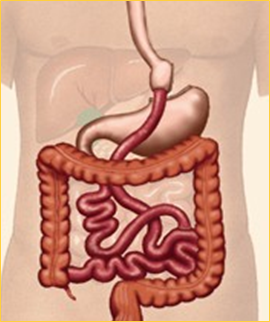Laparoscopic Roux-en-Y Gastric Bypass (Gastric Bypass)
How does the Gastric Bypass work?
A small gastric pouch is created from the upper portion of the stomach. The stomach is reduced from the size of a football to the size of a golf ball. The pouch “new smaller stomach” is attached to the middle of the small intestine with a limb of intestine that has bypassed where digestive enzymes are secreted. This in effect both limits the amount of food consumed and the length of absorption affecting overall calorie intake.
How is the Gastric Bypass performed?
The Gastric Bypass is performed laparoscopically through small incisions. We staple and divide the stomach, creating a smaller pouch. The small intestine is then divided and rerouted in order to create our bypassed limb. The new connections “ anastomosis “ between stomach pouch and small bowel (so called G-J anastomosis) and between two loops of small bowel (so called J-J anastomosis) are both stapled and sutured. The anastomosis is tested with the help of intra-operative esophagogastroscopy.

What are the advantages of the Gastric Bypass?
- 60 to 80 percent excess weight loss
- Restrictive and mal-absorptive procedure
- Increase energy expenditure
What are the disadvantages of the Gastric Bypass?
- More complex operation with greater complication rates
- Can lead to long-term vitamin/mineral deficiencies requiring lifelong supplementation
- Longer hospital stay
What you will experience the day of surgery at

St. Vincent’s Medical Center
On the day of your procedure you will go to the surgery center. You are prepared for surgery and an IV will be put in place at this time. You will be transferred to the holding area to meet your surgeon, your anesthesiologist and OR staff taking care of you. In the OR you will be put asleep after inhaling oxygen enriched air via face mask by intravenously fast acting medication.
After surgery you will be transferred to the recovery room. If you have a history of sleep apnea you will receive extra monitoring at this time.
After you completely awake you may proceed to the nursing floor or to the intensive care unit. Placement in the ICU doesn’t mean that there is a surgical complication – it is usually for a patient who needs very close monitoring due to medical conditions that were present before surgery.
Pain after surgery is controlled by Patient Controlled Analgesia (PCA). This is a computerized pump that allows you to request and receive pain medication whenever you might want it. It is very safe and effective in controlling pain.
A swallow test is performed the next day after surgery. You will be asked to drink a small cup of clear liquid x-ray dye. This test helps us to confirm proper placement of the band.
After the swallow study you will be offered sugar free liquids and diet popsicles.
Discharge and follow-up
- Activity as tolerated. Exercise in encouraged, however, no heavy lifting or strenuous activity for four weeks.
- You may take a bath or shower.
- Abdominal binder for comfort as desired.
- You may remove the Steri-strips after 5 or 6 days.
- You may drive when you are no longer taking pain medication.
Medications
- Resume pre-surgery home medications as instructed by physician.
- Multivitamin twice a day (chewable or liquid).
- Nexium (prescription) or Prevacid (over the counter) for heartburn.
- Roxicet every four hours as needed (prescription) for pain.
Diet
- Drink a lot of water – at least 2 quarts (64 ounces) each day.
- Do not gulp. Take frequent (every 5 to 10 minutes) small sips.
- Clear liquids: Beef, chicken or vegetable broth.
- Diet drinks, such as Crystal Light.
- Sugar-free frozen fruit flavored ice pops, such as Popsicles.
- Sugar-free gelatin, such as Jell-O.
- Flavored waters.
- You may have caffeinated diet drinks sparingly (limit to two 8 ounce servings per day).
- Avoid carbonated beverages.
When to Notify Physician
- Notify your physician if your temperature exceeds 101° F.
- Notify your physician if you experience signs of infection which include redness or drainage from incision site, chills or pain not controlled by pain medications.
- Notify your physician if you have pain and swelling in your leg or calf, if you have chest pain, palpitations or shortness of breath.
- Notify your physician if you are constantly nauseated and/or you vomit for prolong period of time; if you cannot keep down your medications including vitamins.
Additional Instructions may be given based on individual circumstances.
Call 904-389-8871 to schedule follow-up appointment.
If you are Diabetic and seen by Endocrinology associates, please call their office.
This information is selective and does not include all possible side effects and complications resulting from this medical condition, diagnostic procedure or treatment. Potential complications should be discussed in more detail with your physician.

